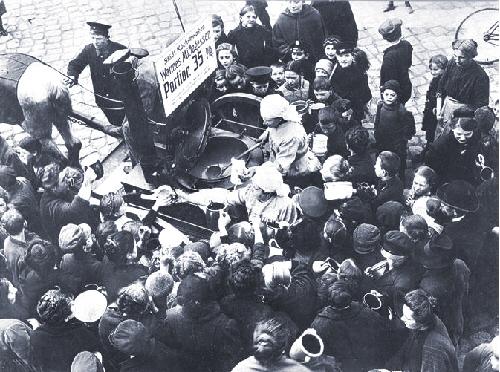None of the nations involved was prepared economically for a long-lasting conflict. After trench warfare set in and the war became a grinding affair, indirect consequences of the war soon affected the civilian population. Missing imports from Russia, Poland, and overseas soon began taking a toll in Germany. In addition, many farmers had been drafted for military service, leading as early as the autumn of 1914 to considerable crop losses and the first bottlenecks in the food supply. In particular, the staples bread and potatoes were soon scarce. Many foods were rationed from 1915 and were available only with food stamps. By 1916 mobile soup kitchens like the one below in Berlin were appearing on German streets.
 |
| A Berlin Mobile Soup Kitchen, 1916 |
A peak in food shortages came with the notorious "Kohlrübenwinter" ("Turnip Winter") of 1916–17. A rainy autumn caused a blight had reduced the harvest to about half of the previous year. An extremely cold winter followed, leading to a significant shortage of coal both in private households and in the railways, so the transportation of potatoes to customers mainly in the big cities was hampered and many potatoes spoiled on the way. As a last ditch measure, turnips – traditionally used as animal feed – were distributed in cities and towns. Two pounds of turnips per week were authorized for each civilian. The turnips were prepared in every conceivable variation. However, there was a total lack of other important nutrients, especially oils and fats. Soup kitchens were established where needy families could eat and find some warmth. In addition, the forests and parks were authorized for deforestation to provide wood for home heating. During the Turnip Winter two notable spikes in mortality were in the adult female population and among the wounded soldiers sent home for recuperation.
 |
| Turnips for Human Consumption |
In 1917 bread rations were further reduced. This increasingly shrinking food supply subsequently led to hunger protests and strikes. The resultant severe undernourishment was particularly telling on the elderly, the young, expectant, and nursing mothers. Improper diet lowered resistance to or caused such diseases as tuberculosis, rickets, influenza, dysentery, scurvy, ulceration of the eyes, and hunger-edema. The influenza epidemic of 1918 had, therefore, a far greater effect on German mortality, which was 250 percent greater in that year than in England. Things were grim not only through the end of the war but also after the Armistice, as the Allies maintained their naval blockade on the defeated powers. German sources estimate that about 700,000 civilians died in 1918, many due to starvation or their vulnerability to the Spanish Influenza caused by malnutrition.
 |
| A Children's Soup Kitchen in Hamburg |
Sources: Various German Websites; The Politics of Hunger: The Allied Blockade of Germany, 1915–1919 by C. Paul Vincent.

A great horror. Helps explain the 1920s in Germany, and the horrors afterwards.
ReplyDeleteI didn't know the blockade continued after 11-11-18.
It's blummin' beautiful isn't it?
DeleteThe Allies kept it up until the Versailles Treaty was signed, and they still couldn't back on their feet; the Allies laying the war guilt trip ..dirty pool. Recall Herbert Hoover and food relief to Belgium. Anyone care to comment on German assistance from the Allies?
ReplyDelete